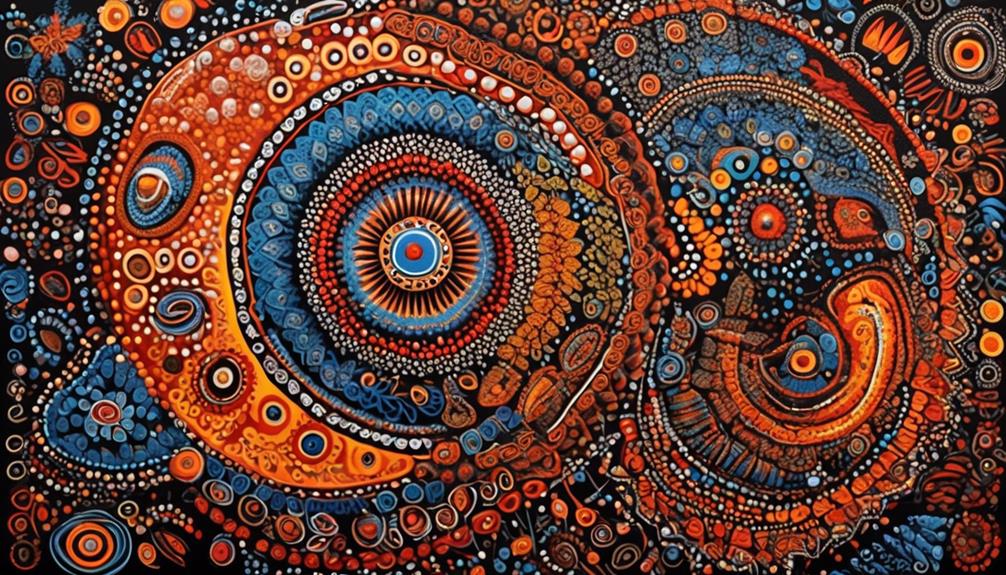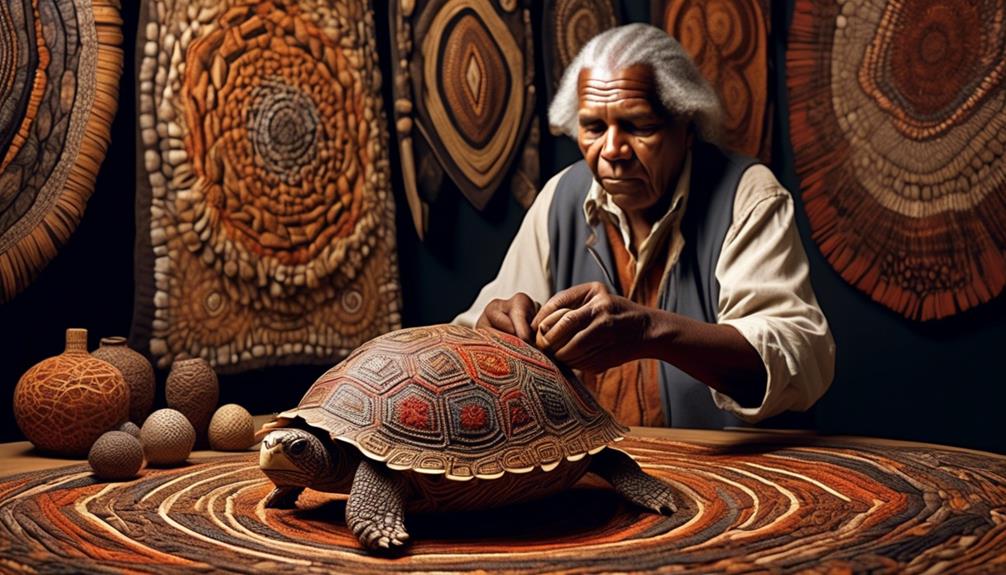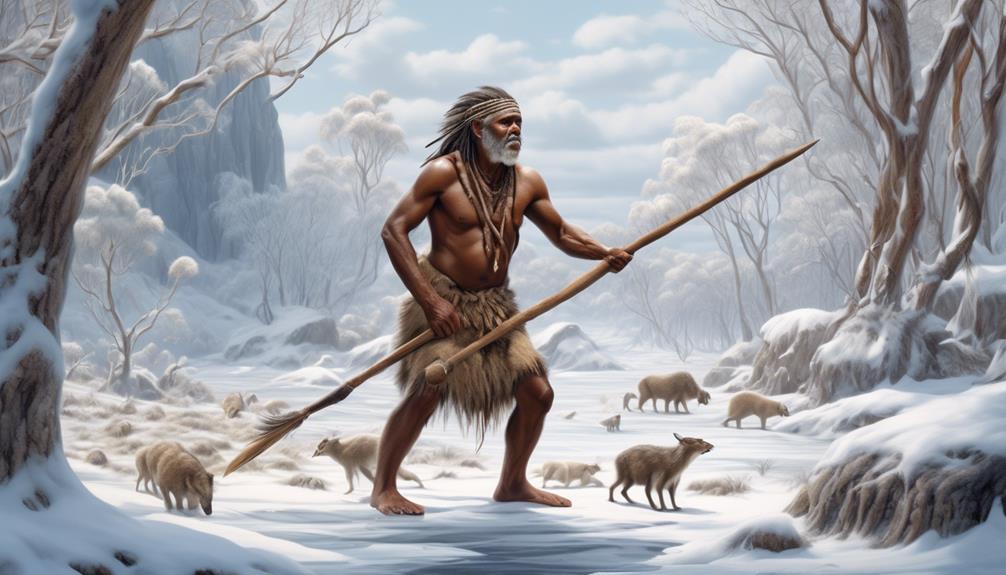Indigenous art showcases a rich and diverse cultural heritage that has evolved over millennia, making it one of the oldest artistic traditions in the world. The intricate connections between Indigenous communities and their lands are intricately portrayed in their artwork, revealing a depth and complexity that may not be readily apparent at first glance.
From traditional techniques to the evolving contemporary interpretations, Aboriginal art offers a window into a complex and fascinating world that continues to shape the global art scene.
Key Takeaways
- Aboriginal art is one of the oldest art forms in the world, dating back tens of thousands of years.
- Traditional techniques such as dot painting and cross-hatching have evolved into contemporary styles, reflecting the deep connection between artists and their ancestral lands.
- Symbolism plays a crucial role in Aboriginal art, with each symbol holding deep cultural and spiritual significance.
- Aboriginal art serves as a form of storytelling, preserving and passing down traditional knowledge and histories, while also challenging stereotypes and fostering intercultural understanding.
History of Aboriginal Art
Aboriginal art has a rich and complex history that reflects the cultural and spiritual traditions of Indigenous Australian communities. The evolution of styles in Aboriginal art is a testament to the deep connection between the artists and their ancestral lands. From rock paintings to contemporary art forms, the journey of Aboriginal art has been a reflection of the evolving Indigenous Australian identity. The impact of Aboriginal art on society has been profound, transcending geographical boundaries and cultural differences.
The evolution of styles in Aboriginal art is a dynamic narrative that encapsulates the changing techniques, motifs, and symbols used by artists over thousands of years. Traditional dot painting, cross-hatching, and intricate patterns have given way to more contemporary styles, demonstrating the adaptability and innovation of Aboriginal artists. This evolution not only reflects artistic growth but also serves as a visual chronicle of the Indigenous Australian experience.
The impact of Aboriginal art on society can't be overstated. It has been instrumental in challenging stereotypes, preserving cultural heritage, and fostering intercultural understanding. Through its depiction of Dreamtime stories, connection to land, and spiritual beliefs, Aboriginal art has played a pivotal role in educating the world about the depth and complexity of Indigenous Australian cultures. Moreover, it has provided economic opportunities for Indigenous communities and empowered artists to share their stories on a global platform. The profound impact of Aboriginal art continues to inspire and enrich societies worldwide.
Traditional Artistic Techniques
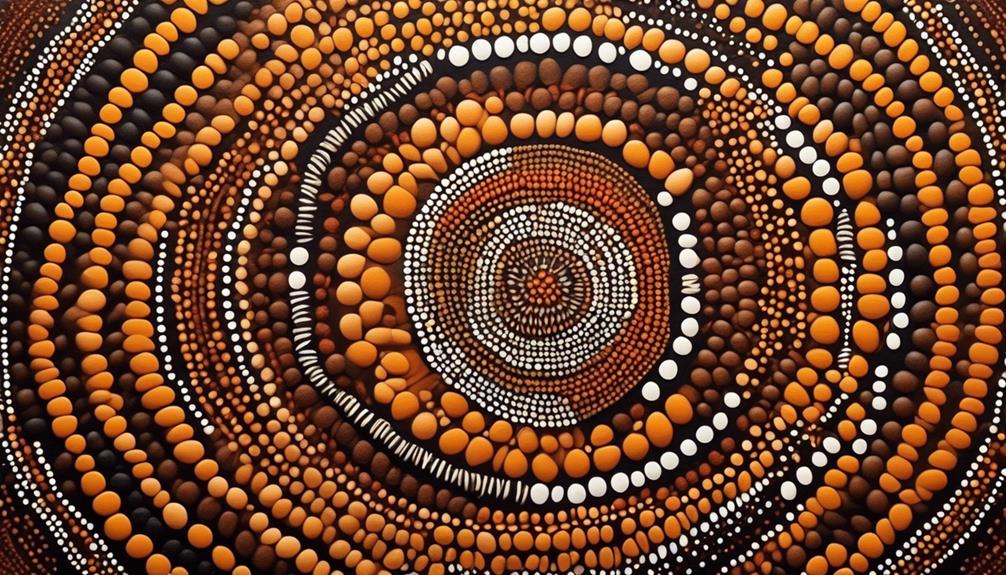
Let's explore the traditional artistic techniques used in Aboriginal art.
The dot painting technique, widely recognized in Aboriginal art, involves the use of intricate dots to create beautiful and meaningful artworks.
Additionally, symbolism plays a crucial role in Aboriginal art, with each symbol holding deep cultural and spiritual significance.
Lastly, natural pigments sourced from the land are often used, connecting the art to the natural world and traditional practices.
Dot Painting Technique
The dot painting technique is a traditional form of artistic expression used by Indigenous Australian communities to convey cultural stories and sacred knowledge through intricate patterns of dots. This technique holds significant cultural importance as it's deeply rooted in the spiritual and ancestral traditions of Aboriginal peoples.
The use of symbols and patterns in dot painting not only serves as a means of artistic expression but also carries profound cultural significance, often depicting stories of the land, creation beliefs, and ancestral beings.
Over time, dot painting has evolved, adapting to modern artistic influences while maintaining its cultural integrity. Its evolution reflects the resilience and adaptability of Indigenous art forms in the face of external influences.
The dot painting technique continues to be a powerful medium for preserving and sharing Indigenous Australian culture with the world.
Symbolism in Art
Exploring the intricate symbolism found within traditional Aboriginal dot paintings reveals a deep understanding of cultural narratives and spiritual beliefs. Symbolism interpretation in Aboriginal art is a profound endeavor, as each symbol carries layers of meaning. For instance, concentric circles often represent campfires or significant locations, while straight lines can symbolize travel paths or ancestral tracks. The cultural expression of these symbols connects the artwork to the land, history, and Dreaming stories of the Aboriginal people. Through careful analysis and cultural understanding, one can unravel the rich tapestry of meaning woven into these artworks, gaining insight into the Aboriginal worldview. This approach respects the depth of Aboriginal culture and its artistic tradition, fostering a greater appreciation for the interconnectedness of symbolism and cultural expression.
| Symbol | Interpretation |
|---|---|
| Circles | Campfires, locations |
| Straight lines | Travel paths, ancestral tracks |
| Dots | Stars, land features |
| U shapes | People, community |
| Wavy lines | Water, rivers, paths |
Natural Pigments Used
Using traditional artistic techniques, Aboriginal artists utilized natural pigments to create their intricate works of art. Natural pigments were sourced from indigenous materials like ochre, charcoal, and clay, each carrying spiritual symbolism and cultural significance.
The process of gathering these pigments was deeply rooted in tradition, often involving ceremonies and storytelling. Ochre, for instance, held symbolic meanings representing life, earth, and ceremonial rituals. The colors derived from these natural pigments were vibrant and enduring, reflecting the connection between the artist, the land, and the ancestral stories being depicted.
The use of traditional techniques and natural pigments not only created visually stunning artwork but also upheld the cultural heritage and spiritual essence of Aboriginal art, fostering a profound respect for the land and its resources.
Symbolism in Aboriginal Art

In Aboriginal art, symbols not only serve as visual elements but also convey deep cultural and spiritual meanings. The symbolism interpretation and cultural representation in Aboriginal art are rich and diverse, reflecting the interconnectedness of the land, ancestral stories, and spiritual beliefs. Here, the use of symbols goes beyond mere decoration; it's a way of communicating complex ideas and passing down cultural knowledge through generations.
- Dreamtime: Aboriginal art often depicts Dreamtime stories, which are the creation myths and spiritual beliefs of the Aboriginal people. These stories are represented through symbols and patterns, each holding specific meanings and teachings.
- Connection to Land: The land holds immense cultural significance for Aboriginal communities, and their art reflects this deep connection. Symbols are used to depict geographical features, tracks of ancestral beings, and sacred sites, embodying the ongoing relationship between the people and their land.
- Spiritual Beliefs: Symbols in Aboriginal art are a visual language for expressing spiritual beliefs and connections to the spirit world. They convey the presence of ancestral beings, totemic animals, and the interconnectedness of all living things.
- Ceremonial Practices: Many symbols in Aboriginal art are associated with sacred ceremonies and rituals. They represent the ceremonial songs, dances, and practices that are integral to maintaining cultural traditions and spiritual harmony.
Understanding the symbolism in Aboriginal art requires delving into the cultural and spiritual contexts, where each symbol becomes a vessel of profound meaning and storytelling.
Cultural Significance of Indigenous Art

Indigenous art holds deep cultural significance. It often conveys spiritual symbolism and reflects the profound connection to the land. These artworks aren't just aesthetically pleasing; they serve as a form of storytelling, preserving and passing down traditional knowledge and histories.
Understanding the cultural significance of Indigenous art is essential in appreciating the richness and complexity of Aboriginal cultures.
Spiritual Symbolism
Spiritual symbolism in Aboriginal art reflects the deep cultural and spiritual significance embedded within the artistic traditions of Indigenous communities.
- Interconnectedness: Aboriginal art often depicts the interconnectedness between the spiritual and natural worlds, illustrating the belief that all living things are interconnected and interdependent.
- Dreamtime Stories: Many artworks convey Dreamtime stories, representing the creation period in Aboriginal belief systems and serving as a way to pass down cultural knowledge and traditions.
- Symbolic Motifs: Various symbols and motifs in Aboriginal art hold deep spiritual meanings, representing elements such as water, land, animals, and ancestral spirits.
- Spiritual Connections: The art serves as a medium for Indigenous people to connect with their spiritual heritage, honoring their ancestors and maintaining a strong spiritual connection to the land.
Connection to Land
Reflecting the deep cultural and spiritual significance of Aboriginal art, the connection to the land holds a profound cultural significance within Indigenous artistic traditions. The spirituality of the land is intricately woven into the art, fostering a deep sense of connection and belonging. This connection goes beyond mere physical proximity; it encompasses spiritual and emotional ties to the land, reflecting the essence of Indigenous identity and cultural integrity. The relationship between the artist and the land is symbiotic, with the land providing inspiration and the artist honoring and preserving its essence through their creations. This deep-rooted connection also extends to the advocacy for land rights, as Aboriginal art serves as a powerful medium for expressing and asserting the importance of preserving the land and its cultural significance.
| Connection to Land | Cultural Significance |
|---|---|
| Spiritual | Fosters belonging |
| Land rights | Advocacy |
| Cultural integrity | Preserving essence |
Evolution of Aboriginal Art
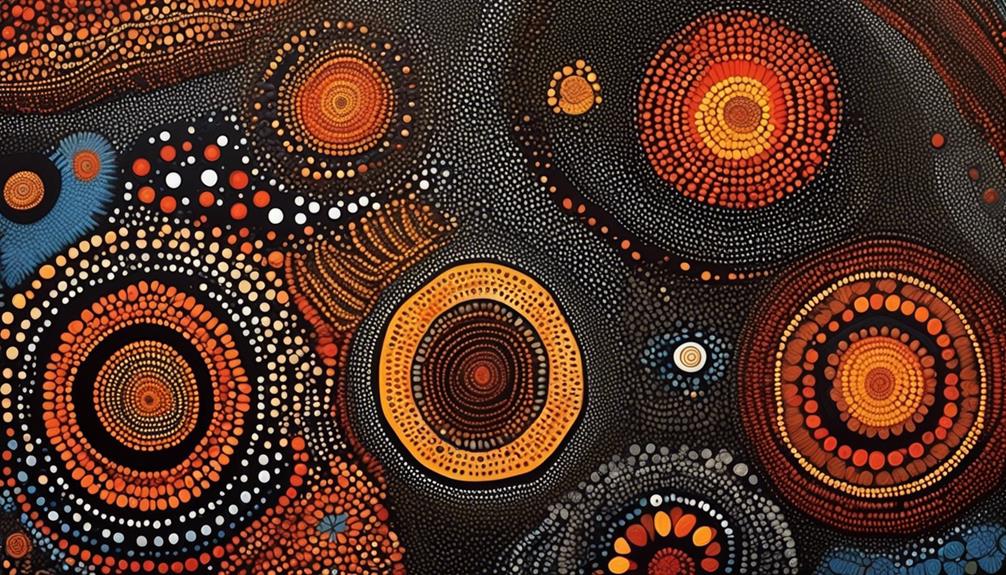
The evolution of Aboriginal art reflects the complex and diverse cultural history of the Indigenous peoples of Australia. This evolution has been shaped by a myriad of evolutionary influences and contemporary interpretations, resulting in a rich tapestry of artistic expression that continues to captivate audiences worldwide.
- Traditional Techniques Meet Modern Innovation: The evolution of Aboriginal art has seen a seamless integration of traditional artistic techniques with modern innovation, showcasing the adaptability and resilience of Indigenous artistic practices.
- Representation of Cultural Identity: Aboriginal art has evolved to become a powerful tool for the representation and preservation of cultural identity, serving as a means of asserting sovereignty and reclaiming narratives that have been historically marginalized.
- Exploration of Socio-Political Issues: Contemporary Aboriginal art has evolved to encompass a diverse range of socio-political themes, effectively engaging with issues such as environmental conservation, social justice, and Indigenous rights.
- Global Influence and Collaboration: The evolution of Aboriginal art has transcended geographical boundaries, leading to collaborative efforts with artists and communities worldwide, fostering cross-cultural exchange and understanding.
The evolution of Aboriginal art continues to be a dynamic and evolving phenomenon, reflecting the resilience, creativity, and cultural significance of Indigenous peoples. As the art form continues to evolve, it serves as a testament to the enduring legacy and ongoing vitality of Aboriginal artistic expression.
Indigenous Art Materials and Tools
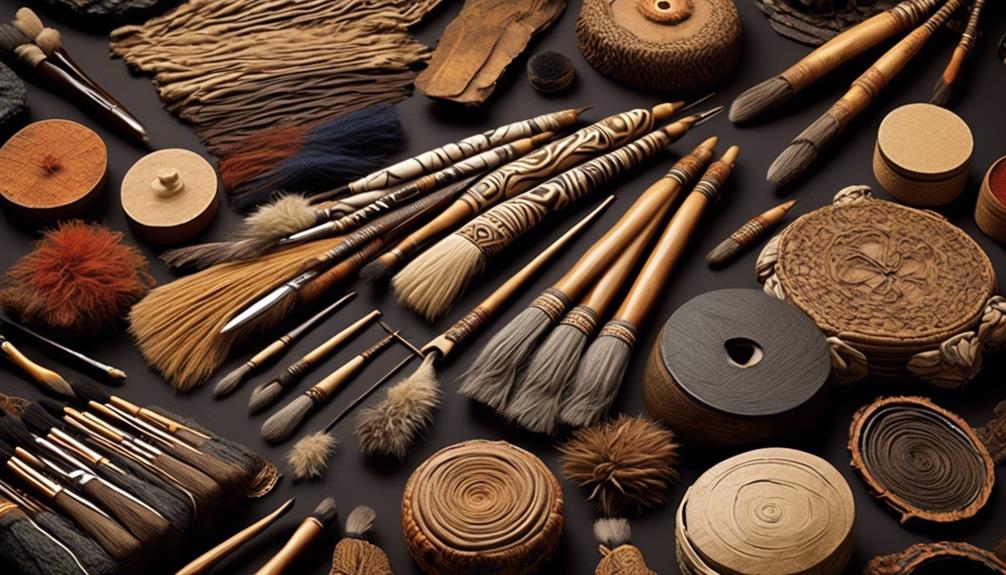
Artists within Indigenous communities often utilize a diverse array of materials and tools to create their artworks, drawing from both traditional and contemporary resources. Indigenous art preservation is deeply intertwined with the use of traditional artistic tools and techniques, which have been passed down through generations.
Traditional materials such as natural pigments, ochre, clay, and bark are often used in the creation of Indigenous art. These materials are sourced from the land, reflecting a deep connection to the environment and a sustainable approach to art-making. The use of traditional materials not only connects the artists to their cultural heritage but also contributes to the preservation of Indigenous artistic practices.
In addition to traditional materials, Indigenous artists also incorporate contemporary tools and techniques into their practice. For example, while traditional dot painting may have been done using natural brushes made from plant materials, contemporary artists may also use store-bought brushes for their intricate designs. This incorporation of modern tools allows for innovation and adaptation while still honoring traditional artistic processes.
Furthermore, the use of traditional tools such as carving implements, wooden painting tools, and natural brushes is a testament to the resourcefulness and creativity of Indigenous artists. These tools are often handmade, emphasizing the skill and craftsmanship involved in creating Indigenous art.
Regional Styles of Aboriginal Art
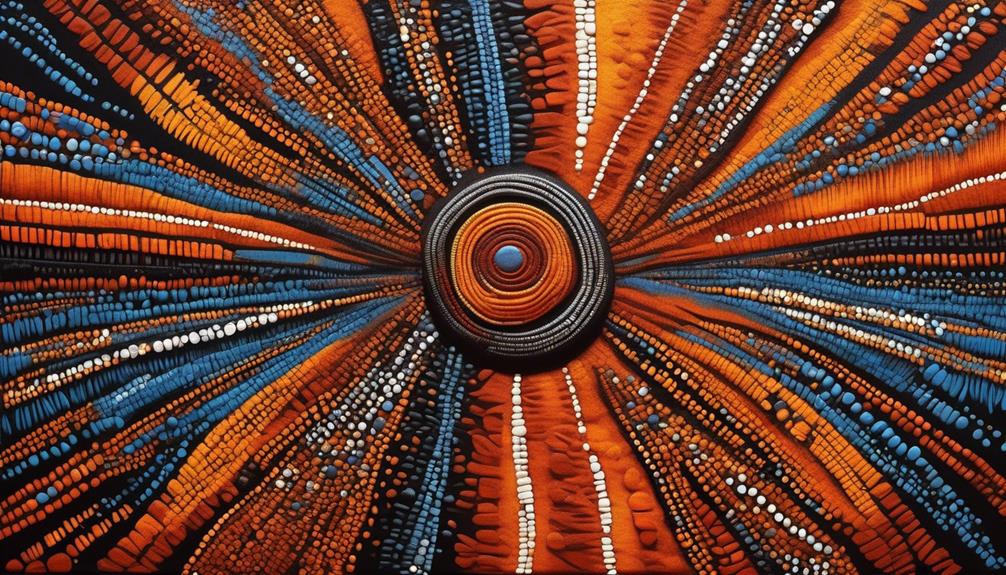
As we explore the regional styles of Aboriginal art, we can appreciate the rich symbolism embedded in these works.
Each region's techniques and materials reflect a deep connection to the land and its stories.
Symbolism in Art
Regional styles of Aboriginal art reflect the diverse cultural symbolism and storytelling traditions of different Indigenous communities across Australia. Symbolism interpretation and artistic expression are integral to understanding the rich tapestry of Aboriginal art. This art form is imbued with meaning and significance, conveying stories of creation, spirituality, and connection to the land.
The use of symbols and motifs varies across different regions, each carrying its own unique cultural significance. Some common symbols include:
- Dot Painting: Representing sacred sites, waterholes, and ancestral stories.
- Cross-Hatching: Depicting kinship relationships and traditional ceremonies.
- Animal Tracks: Symbolizing the presence of ancestral beings and their journeys.
- X-Ray Art: Revealing the internal essence and spirit of animals and humans.
Through these symbols, Aboriginal artists communicate their deep connection to their heritage and the natural world, inviting viewers to engage with the layers of meaning embedded within each artwork.
Techniques and Materials
In exploring the diverse regional styles of Aboriginal art, one can appreciate the intricate techniques and unique materials employed by Indigenous artists to convey their cultural stories and traditions. Traditional techniques such as cross-hatching, dot painting, and stenciling are used to create intricate patterns and symbols that hold deep cultural significance. These techniques are often passed down through generations, preserving the richness of Aboriginal art. Indigenous materials such as natural ochres, clays, and organic pigments play a vital role in adding authenticity to the artwork, as they are sourced from the land, reflecting the strong connection to the environment. The table below provides a glimpse into the regional diversity of Aboriginal art techniques and materials, highlighting the distinct styles and cultural symbolism embedded within each art form.
| Region | Traditional Techniques | Indigenous Materials |
|---|---|---|
| Central Australia | Dot painting, Stippling | Ochre, Mulga wood, Sand |
| Arnhem Land | Cross-hatching, Rarrk | Natural ochres, Bark |
| Western Desert | Line work, Sgraffito | Spinifex resin, Desert sand |
| Kimberley | Boab nut carving, Wandjina | Ochre, Boab nut, Pandanus fiber |
| Tiwi Islands | Carving, Sgraffito | Ironwood, Natural ochres |
Contemporary Aboriginal Art Movement
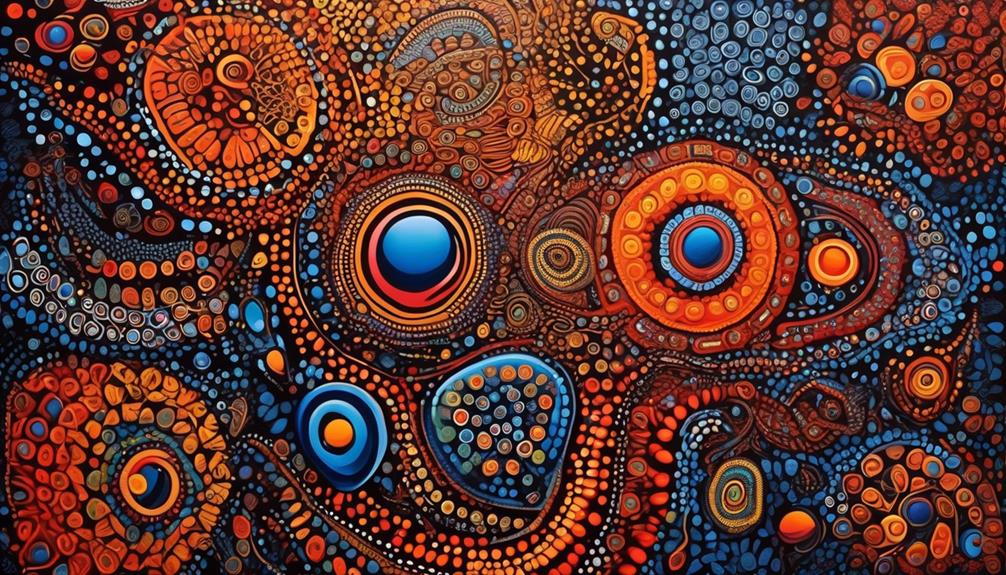
The rise of the Contemporary Aboriginal Art Movement has sparked a renaissance in the artistic expression of Indigenous Australians. This movement has brought about a profound shift in the way Aboriginal art is created and perceived, challenging traditional notions and embracing contemporary interpretations. The Contemporary Aboriginal Art Movement has opened up new avenues for artistic innovation, allowing Indigenous artists to explore a wide range of mediums and techniques while staying true to their cultural heritage.
Here are some key aspects of this movement that have contributed to its significance:
- Cultural Resurgence: The Contemporary Aboriginal Art Movement has been instrumental in reviving and preserving traditional Indigenous art forms, fostering a reconnection to ancestral stories and cultural practices.
- Cross-Cultural Dialogue: Through contemporary Aboriginal art, there's a dynamic exchange of ideas and perspectives between Indigenous and non-Indigenous communities, promoting understanding and reconciliation.
- Social Commentary: Many contemporary Aboriginal artists use their work as a platform to address social and political issues, shedding light on the ongoing struggles and triumphs of Indigenous peoples.
- Global Recognition: The movement has gained international acclaim, leading to a broader appreciation of Aboriginal art on the global stage, amplifying the voices of Indigenous artists worldwide.
The Contemporary Aboriginal Art Movement continues to evolve, empowering Indigenous artists to push boundaries, challenge stereotypes, and assert their presence in the contemporary art world.
Impact of Colonization on Aboriginal Art
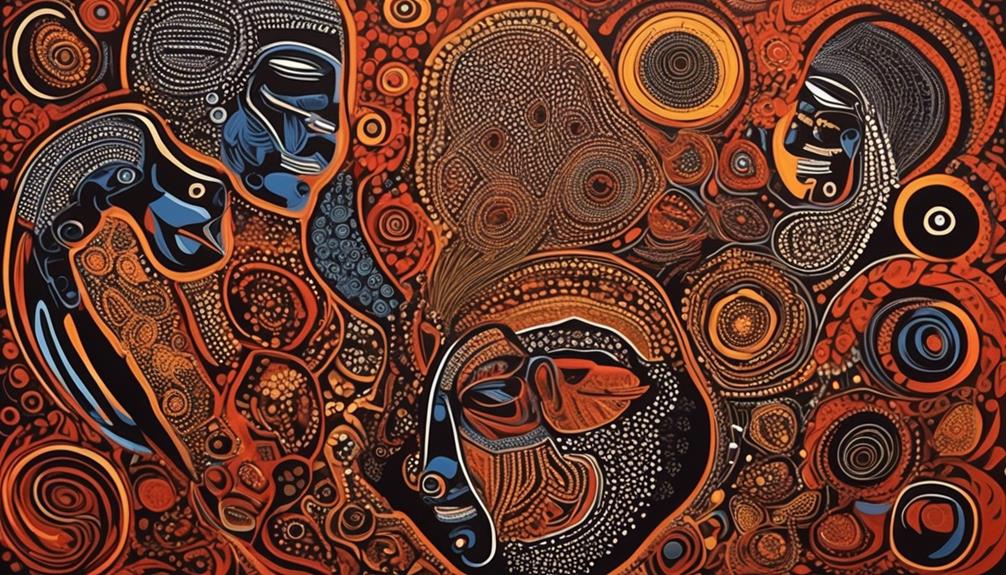
The profound impact of colonization on Aboriginal art is evident in the historical transformation of artistic expression within Indigenous communities, reflecting a complex interplay of cultural, social, and political dynamics. The arrival of colonizers led to significant disruptions in the traditional artistic practices of Aboriginal peoples. The imposition of Western artistic standards and the suppression of Indigenous cultural expressions resulted in a loss of artistic autonomy. Additionally, the impact of globalization has introduced new challenges, as Aboriginal art has become commodified and exploited in the global art market, often without proper recognition or compensation for the artists.
Cultural appropriation in art has further exacerbated the challenges faced by Aboriginal artists. The appropriation of Indigenous artistic styles and symbols by non-Indigenous artists has raised concerns about the exploitation and misrepresentation of Aboriginal culture. This has led to a necessary dialogue about the ethical considerations surrounding the creation and consumption of Indigenous art. Indigenous artists and communities are advocating for greater respect for the cultural and spiritual significance of their artistic traditions.
Despite these challenges, Aboriginal artists have also used their work as a form of resistance and resilience. Through their art, they assert their cultural identities, challenge stereotypes, and reclaim their narratives. The impact of colonization on Aboriginal art underscores the ongoing struggles for cultural recognition and the need to address the power imbalances within the art world.
Indigenous Art and Land Rights
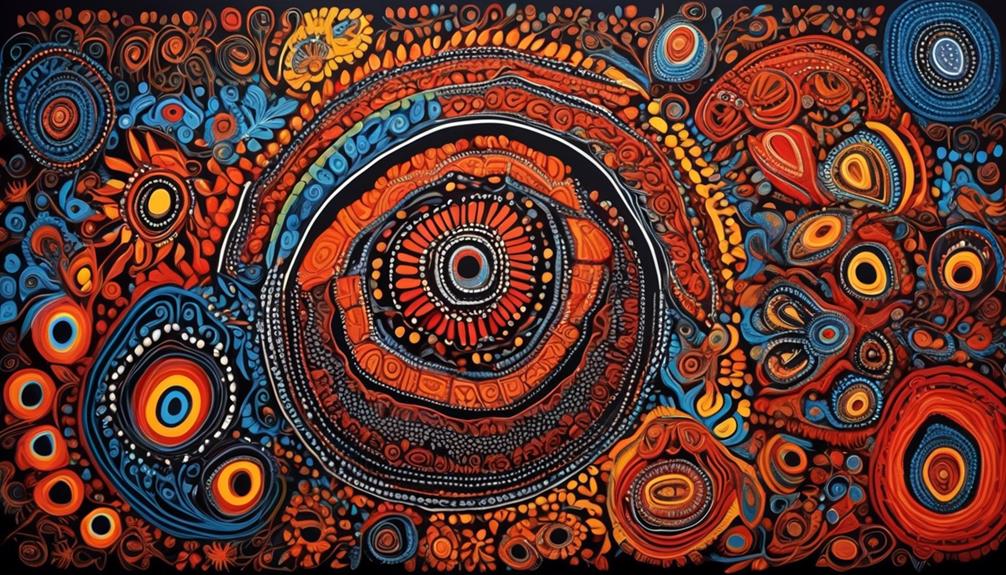
Delineating the relationship between Indigenous art and land rights offers a nuanced perspective on the intricate connections between cultural expression and territorial sovereignty. This interplay is crucial in understanding the ongoing struggles for Indigenous land rights and the role of artistic expression in preserving cultural heritage.
- Land Rights: The link between Indigenous art and land rights is deeply rooted in the connection of Indigenous communities to their ancestral lands. This connection forms the basis of their cultural identity and artistic inspiration.
- Cultural Preservation: Indigenous art serves as a powerful tool for cultural preservation, transmitting traditional knowledge and stories across generations. It embodies the spiritual and historical significance of the land, reinforcing the Indigenous connection to their territories.
- Indigenous Creativity: The artistic expressions of Indigenous communities aren't only a manifestation of creativity but also an assertion of their rights to the land. Through art, Indigenous peoples assert their presence, resilience, and ongoing connection to their territories.
- Artistic Expression: Indigenous art is a form of resistance and resilience in the face of land dispossession and cultural erasure. It serves as a platform to voice the ongoing struggles for land rights and the complexities of Indigenous identity in contemporary society.
Understanding the intersection of Indigenous art and land rights provides insight into the ongoing challenges faced by Indigenous communities and the significance of cultural expression in the fight for liberation and sovereignty.
Role of Art in Aboriginal Communities

Exploring the significance of art within Aboriginal communities reveals a rich tapestry of cultural expression and communal identity. The role of art in Aboriginal communities is deeply intertwined with community empowerment. Art serves as a powerful tool for preserving and perpetuating cultural traditions, fostering a sense of belonging, and promoting social cohesion.
Through art, we, as Aboriginal people, reclaim our narratives, challenge stereotypes, and assert our presence in the broader social fabric.
Art plays a pivotal role in community empowerment by providing a platform for self-expression and cultural revitalization. It serves as a medium through which our stories, histories, and experiences are communicated, ensuring that our voices are heard and our perspectives are acknowledged. Art also acts as a catalyst for social change, addressing issues of social justice, inequality, and discrimination. It enables us to engage with wider society, fostering understanding and mutual respect.
Moreover, the creation of art within Aboriginal communities fosters a sense of pride and resilience, empowering individuals to celebrate their heritage and confront the challenges they face. Art-making processes often involve collective efforts, nurturing a sense of solidarity and shared purpose. This communal engagement not only strengthens social bonds but also provides a platform for intergenerational knowledge transfer, ensuring the continuity of cultural practices and values.
In essence, the role of art in Aboriginal communities is multifaceted, serving as a vehicle for empowerment, cultural preservation, and social transformation. It's a testament to our resilience, creativity, and unwavering commitment to shaping our own narratives.
Aboriginal Art in the Global Art Market
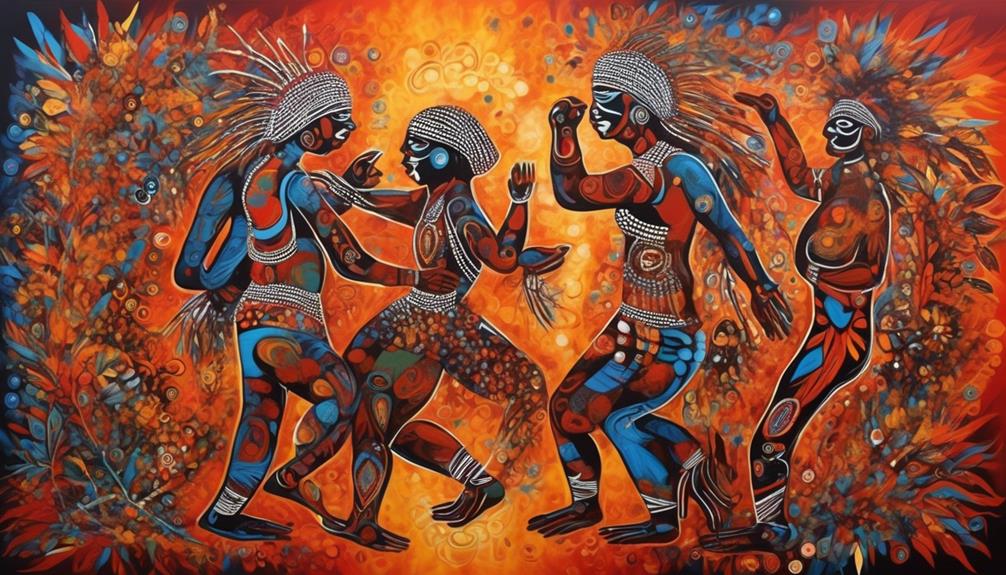
Navigating the complexities of the global art market, we find that Aboriginal art holds a significant place in the contemporary art world. This unique form of artistic expression has been increasingly recognized and valued within the global art market, contributing to a broader conversation about Indigenous representation and the intersection of traditional and contemporary art forms.
- Cultural Resilience: Aboriginal art serves as a powerful testament to the resilience and richness of Indigenous cultures, challenging dominant narratives and providing a platform for cultural empowerment.
- Market Demand: The growing demand for Aboriginal art in the global art market reflects a shift towards appreciating diverse artistic perspectives and narratives, creating economic opportunities for Indigenous artists and communities.
- Artistic Innovation: Aboriginal artists are actively engaging with contemporary art practices, blending traditional techniques with modern influences, thus contributing to the evolution of artistic expression on a global scale.
- Ethical Considerations: As Aboriginal art gains prominence in the global art market, ethical considerations regarding fair compensation, cultural appropriation, and respectful collaboration with Indigenous artists become increasingly significant.
The presence of Aboriginal art in the global art market not only enriches the artistic landscape but also fosters a greater understanding of Indigenous cultures and their enduring contributions to the world of art. As we continue to navigate the complexities of the art market, it's essential to recognize and support the voices and creativity of Indigenous artists, ensuring their rightful place in the global artistic dialogue.
Preservation and Authenticity of Aboriginal Art
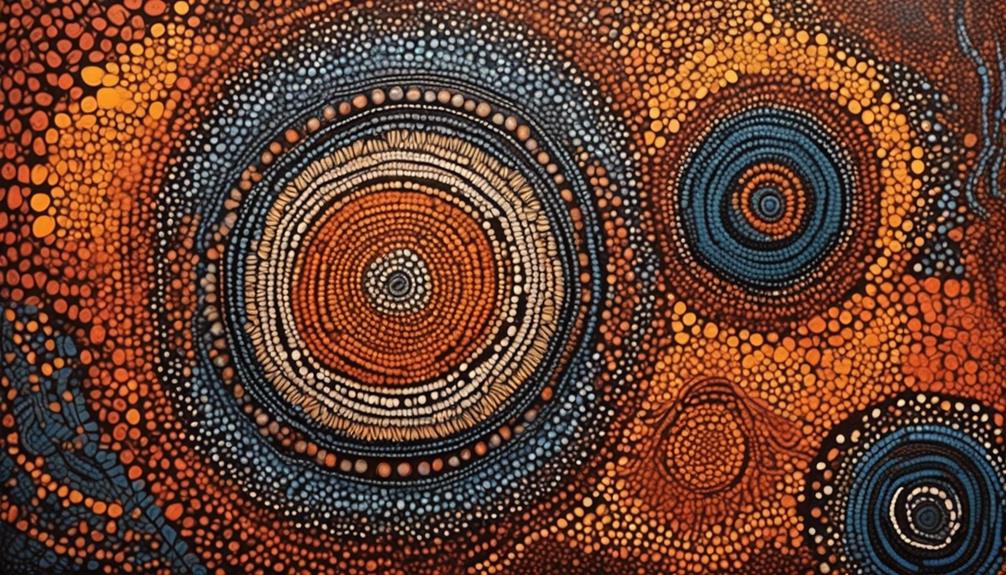
When considering the preservation and authenticity of Aboriginal art, it's crucial to address the issues of artistic integrity and cultural appropriation.
These are complex and sensitive topics that require careful examination and understanding. We must strive to uphold the integrity of Aboriginal art while also respecting the cultural significance and heritage it represents.
Artistic Integrity
Preserving the authenticity of Aboriginal art is crucial in maintaining the integrity and cultural significance of these artistic expressions. When considering artistic integrity in Aboriginal art, it's important to delve into the ethical representation of cultural symbols and stories. This involves understanding the significance of each artwork and its connection to the artist's heritage.
To ensure the preservation of artistic integrity, the following key aspects should be considered:
- Cultural Context: Understanding the historical and cultural background behind each artwork.
- Community Involvement: Engaging with Aboriginal communities to ensure respectful representation.
- Traditional Techniques: Honoring the traditional methods and materials used in creating the art.
- Artistic Evolution: Recognizing the contemporary influences while respecting the roots of the art form.
Cultural Appropriation
In considering the preservation and authenticity of Aboriginal art, it's imperative to address the issue of cultural appropriation with sensitivity and critical awareness. The appropriation debate surrounding Aboriginal art raises important questions about respect for Indigenous cultures and the ethical use of artistic expressions.
It's essential to acknowledge the historical context of colonization and the ongoing impact on Indigenous communities. Cultural sensitivity is paramount in the creation and consumption of Aboriginal art, as it reflects the stories, traditions, and spiritual connections of the Aboriginal people.
Engaging in this dialogue with open minds and a willingness to understand diverse perspectives is crucial for promoting the preservation and authenticity of Aboriginal art. By actively participating in the cultural appropriation debate, we can work towards a more respectful and inclusive representation of Indigenous art within the broader artistic landscape.
Indigenous Artists Making a Difference

Indigenous artists are actively shaping and influencing the world of art with their unique perspectives and cultural insights. Their work goes beyond aesthetic value, making a profound social impact and contributing to the global conversation on indigenous perspectives.
Here are some key ways in which indigenous artists are making a difference:
- Reviving Traditional Art Forms: Many indigenous artists are reviving traditional art forms that were at risk of being lost. By doing so, they aren't only preserving their cultural heritage but also introducing these art forms to a wider audience, fostering greater appreciation and understanding.
- Challenging Stereotypes: Through their art, indigenous artists challenge stereotypes and misconceptions about indigenous cultures. They provide a platform for authentic representation, breaking down barriers and fostering a more inclusive society.
- Advocating for Social Justice: Indigenous artists often use their platform to advocate for social justice issues that affect their communities. Their art becomes a powerful tool for raising awareness, promoting dialogue, and inspiring positive change.
- Empowering Indigenous Youth: Many indigenous artists are actively involved in mentoring and empowering the next generation of indigenous creatives. By sharing their knowledge and experience, they're nurturing a new wave of talent and ensuring the continuity of indigenous artistic traditions.
The work of indigenous artists isn't only enriching the art world but also contributing to a more inclusive, equitable, and culturally diverse society. Their influence extends far beyond the canvas, leaving a lasting impact on the world.
Appreciating and Supporting Aboriginal Art
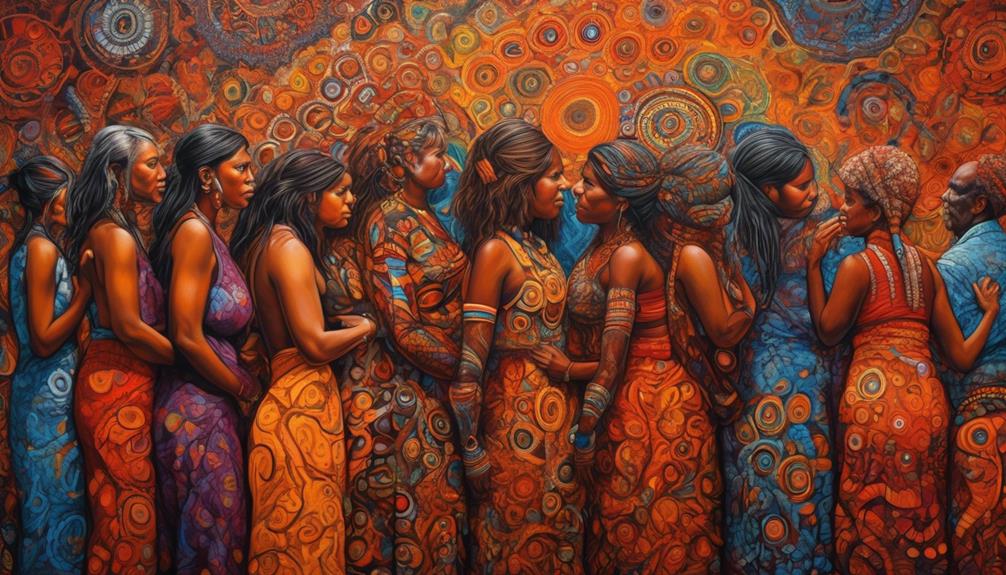
Appreciating and supporting Aboriginal art enriches our cultural landscape while fostering greater understanding and appreciation for the unique perspectives and traditions of Indigenous artists. It's essential to recognize the significance of Aboriginal art as a form of cultural expression and storytelling that has been passed down through generations. By appreciating culture, we not only honor the creativity and skill of the artists but also acknowledge the deep historical and spiritual connections embedded in their work.
Supporting Indigenous artists is crucial in promoting cultural diversity and preserving traditional art forms. It provides economic empowerment and opportunities for Indigenous communities, allowing them to share their heritage with the world on their own terms. When we invest in Aboriginal art, whether through purchasing artwork or attending exhibitions, we contribute to the sustainability of Indigenous artistic practices and help bridge the gap between different cultural perspectives.
Furthermore, supporting Indigenous artists goes beyond the art itself; it's about recognizing and respecting the rights of Indigenous peoples to control and benefit from their cultural heritage. This includes ensuring that artists are fairly compensated for their work and that their cultural and intellectual property rights are upheld.
Frequently Asked Questions
How Do Aboriginal Artists Ensure the Authenticity and Preservation of Their Artwork in the Modern Age?
We ensure the authenticity and preservation of our artwork by utilizing preservation techniques and adapting to modern challenges.
Cultural appreciation and ethical support play a crucial role in maintaining the integrity of our art.
These efforts are essential for protecting our heritage and ensuring our traditions are respected.
We're committed to navigating the complexities of the modern age while upholding the authenticity and significance of our artwork.
What Are Some Ways That Non-Indigenous Individuals Can Appreciate and Support Aboriginal Art Without Appropriating or Exploiting It?
We can appreciate and support indigenous art through ethical engagement and responsible patronage.
Cultural understanding is key for appreciating and supporting art without exploiting it. It's important to engage with the art in a respectful manner and to educate ourselves on the cultural significance behind it.
How Have Indigenous Artists Made a Difference in the Representation and Recognition of Aboriginal Art on a Global Scale?
Indigenous artists have made a significant difference in the global recognition and representation of their art. Their work has elevated the authenticity and preservation of their culture, making a lasting impact on a global scale.
Through their creativity and storytelling, indigenous artists have challenged stereotypes and brought forth a more accurate and respectful understanding of their art. Their contributions have been instrumental in reshaping the narrative and gaining the recognition they deserve.
What Are Some Common Misconceptions About Aboriginal Art and How Can They Be Addressed and Corrected?
Misconceptions about any cultural art can hinder appreciation and support for artists. Correcting misunderstandings requires education and open dialogue.
By providing accurate information and promoting diverse voices, we can dismantle misconceptions and foster a deeper understanding and respect for indigenous art.
It's important to actively engage with the art and artists, listen to their stories, and recognize the richness and significance of their cultural contributions.
How Does the Cultural Significance of Indigenous Art Influence the Contemporary Aboriginal Art Movement and the Evolution of Traditional Artistic Techniques?
The cultural preservation of indigenous art deeply influences the contemporary aboriginal art movement. The evolution of traditional artistic techniques is driven by the need for artistic innovation while honoring cultural significance.
The fusion of tradition and modernity in indigenous art reflects the dynamic nature of the art form. This balance allows for the continuation of cultural heritage while embracing new creative expressions, fostering a vibrant and evolving artistic landscape.
Conclusion
In conclusion, Aboriginal art is a vibrant tapestry that weaves together the stories, traditions, and identity of Indigenous peoples.
Like a river flowing through time, it carries the wisdom and spirit of ancient cultures into the modern world.
As we navigate the currents of the global art market, let's anchor ourselves in the appreciation and support of Aboriginal art, ensuring its preservation and authenticity for generations to come.
